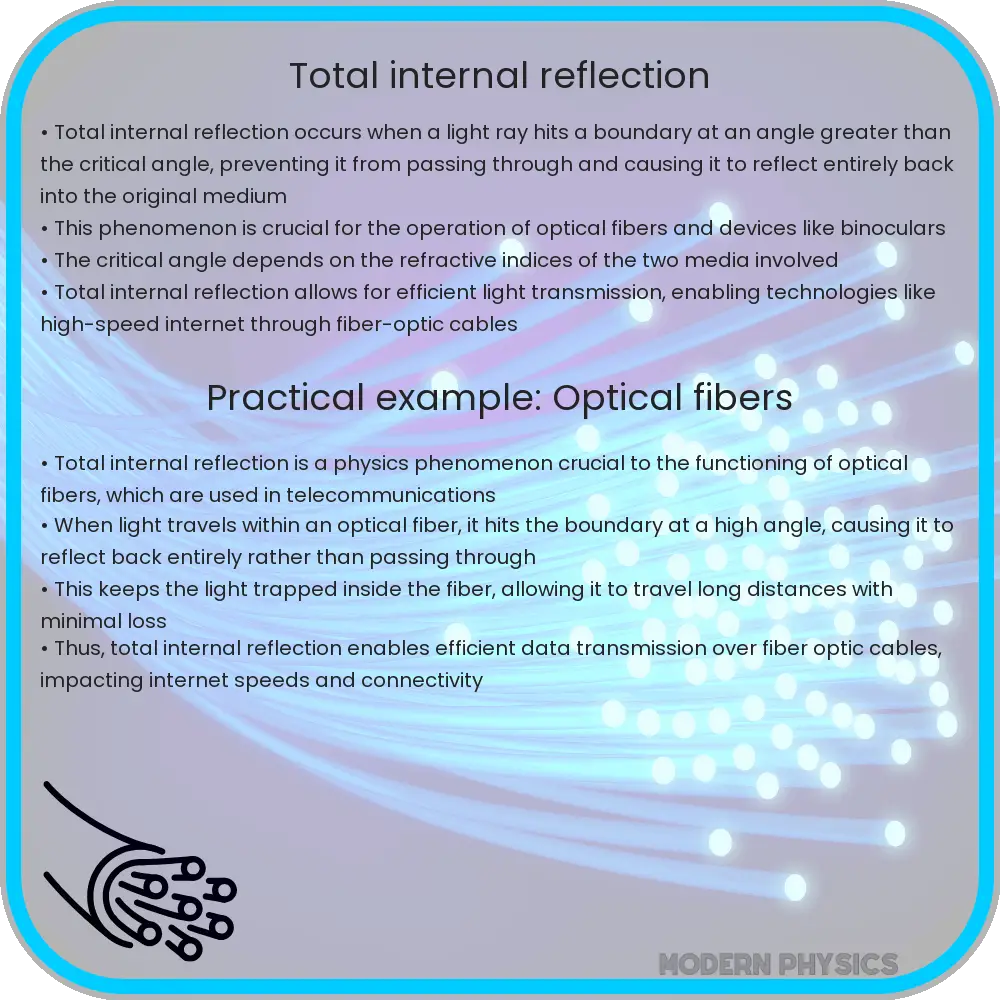Explore the principles, applications, and future of Total Internal Reflection in optics, from fiber optics to holographic displays.

Understanding Total Internal Reflection
Total Internal Reflection (TIR) is a fascinating optical phenomenon that occurs when a light ray traveling through a medium reaches a boundary with a less dense medium at an angle greater than the critical angle. The critical angle is the minimum angle of incidence above which light is completely reflected back into the medium, rather than refracting (bending) into the second medium. This principle is foundational in optics and has numerous applications in modern technology.
Principles of Total Internal Reflection
At the heart of TIR are the concepts of refraction and the refractive index. Refraction is the bending of light as it passes from one medium to another with a different density. The refractive index, denoted as n, is a measure of how much a substance can bend light. The critical angle for TIR can be calculated using Snell’s Law, which states:
n1sinθ1 = n2sinθ2
Where n1 and n2 are the refractive indices of the two media, and θ1 and θ2 are the angles of incidence and refraction, respectively. When light travels from a denser to a rarer medium (e.g., from water to air), and the angle of incidence exceeds the critical angle, TIR occurs.
Applications of Total Internal Reflection
The applications of TIR are diverse and span across various fields:
- Optical Fibres: TIR is the principle behind the functioning of optical fibers, which are used for high-speed data transmission. Light signals entering the fiber at a certain angle are totally internally reflected along the length of the fiber, enabling efficient data transfer over long distances without significant loss.
- Fiber Optic Sensors: These sensors utilize TIR to measure various physical properties like temperature, pressure, and strain. They are prized for their high sensitivity and resistance to electromagnetic interference.
- Binoculars and Periscopes: TIR is used in the prisms of binoculars and periscopes to invert images and direct light paths, providing clear and correctly oriented views.
In addition to these, TIR finds applications in medical imaging devices, rangefinders, and even in nature, as seen in the mirage effect.
Optics of Total Internal Reflection
The optics of TIR are governed by the laws of reflection and refraction. Unlike regular reflection, where some light is absorbed or scattered, TIR results in almost 100% reflection of light, making it highly efficient. This efficiency is crucial in applications like fiber optics, where preserving the intensity and quality of light over long distances is essential. The angles involved in TIR are also crucial for the design and functioning of optical devices, requiring precise calculations and alignments to achieve the desired effects.
Understanding the principles of TIR and its applications opens a window into the intricate world of optics and its vast implications in technology and everyday life.
Is this conversation helpful so far?
Advanced Applications and Future Potential of Total Internal Reflection
The realm of Total Internal Reflection extends far beyond traditional applications, venturing into innovative and futuristic technologies. Advancements in material science and optical engineering are continually expanding the potential of TIR.
- Underwater Communication Networks: Optical fibers, relying on TIR, are being explored for creating high-speed communication networks beneath oceans. This technology could revolutionize global data connectivity.
- Touchscreen Technology: Modern touchscreens often employ TIR. Infrared light is internally reflected within the screen. When a finger touches the screen, it disrupts the reflection, allowing the device to pinpoint the touch location.
- Holographic Displays: Emerging holographic display technologies use TIR to project 3D images into the air, promising a new era of interactive media and advertising.
As we continue to innovate, TIR could play a pivotal role in developing more efficient solar energy systems, advanced security systems using infrared sensors, and even in quantum computing where maintaining the integrity of light signals is paramount.
Challenges and Considerations in Total Internal Reflection
While TIR offers immense benefits, there are challenges and considerations in its application. Precision in the manufacturing of optical components, such as fibers and prisms, is critical for effective TIR. Any imperfections can lead to signal loss or distortion. Environmental factors, like temperature fluctuations and mechanical stress, can also impact the efficiency of TIR in optical systems.
Conclusion
Total Internal Reflection is not just a fundamental optical principle but a cornerstone in the development of modern technologies. From the depths of the oceans to the realm of high-speed internet, TIR continues to be instrumental in shaping the future of communication, entertainment, and science. As we march towards an increasingly digital and interconnected world, the understanding and application of TIR will become more vital, opening new horizons in technological innovation. It’s a testament to the profound impact that a deep understanding of natural phenomena can have in advancing human technology and improving our everyday lives.
Exploring the depths of Total Internal Reflection reveals a world where physics meets practicality, leading to innovations that have revolutionized and will continue to revolutionize our way of living, communicating, and exploring the mysteries of the universe.
